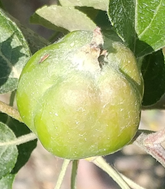Tree Fruit Newsletter – June 7, 2023 – Fruit Thinning Concerns

It’s been a tricky season for thinning after the May 18th freeze and now with the prolonged cold, rainy weather. For those of us who had very little freeze damage and excessive fruit set, the temperature has been too hot or too cold. Cold temperatures make thinners less effective, and hot weather makes them over-effective or capable of scarring fruit.
To make matters more complicated, cold weather can delay the action of thinners beyond the normal 7 to 10 days. Thinners applied at petal fall should be taking effect by now. Chemically thinned fruit can be pulled off the cluster without much force. Do not bend the fruit when doing this test. For thinners applied last week, it’s too soon to see if they have had any effect. However, the fruit will soon reach a size where they are too large for chemical thinning (15 to 18 mm or ¾”), and this will likely occur before we can see the effects of the thinner applied in the last week.
My best guess as to what to do depends on how much set has occurred. Where fruit are set in clusters of 2 on average, it’s safe to hold off on additional thinner. Some of these will fall during June drop. Where they are still set with 3 or more per cluster, you may need another thinner application. If fruit are 15 mm or larger, it will take carbaryl in combination with another thinner to get any thinning at this late stage.

The next period of warm weather will be Sunday, and many orchards will be approaching the final window for thinning. Temperatures will be too cold for good thinning before this, but if you have no other option and you need to thin, you should apply thinner when you can. Orchards north of Bangor should use this upcoming warm weather to apply chemical thinners because it looks like it will cool down again.
The NEWA (Integrated Pest Management Crop Production Tools | NEWA (cornell.edu)) model for predicting thinner efficacy does not yet have stations in Maine that measure solar radiation. Sunlight is an important factor in how well thinners work, so the predictive model can’t predict it without this data. We can look into purchasing a weather station with the right instruments.
Best of luck to everyone,
Renae E. Moran
University of Maine Cooperative Extension
PO Box 179
Monmouth, ME 04259
(207) 933-2100
rmoran@maine.edu
The University of Maine is an EEO/AA employer, and does not discriminate on the grounds of race, color, religion, sex, sexual orientation, transgender status, gender expression, national origin, citizenship status, age, disability, genetic information or veteran’s status in employment, education, and all other programs and activities. The following person has been designated to handle inquiries regarding non-discrimination policies: Director of Equal Opportunity, 101 Boudreau Hall, University of Maine, Orono, ME 04469-5754, 207.581.1226, TTY 711 (Maine Relay System).
